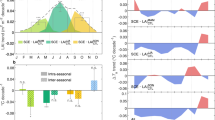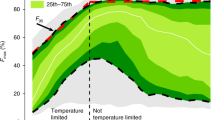Abstract
We present a study that suggests greening in the circumpolar high-latitude regions amplifies surface warming in the growing season (May–September) under enhanced greenhouse conditions. The investigation used a series of climate simulations with the Community Atmospheric Model version 3—which incorporates a coupled, dynamic global vegetation model—with and without vegetation feedback, under both present and doubled CO2 concentrations. Results indicate that climate warming and associated changes promote circumpolar greening with northward expansion and enhanced greenness of both the Arctic tundra and boreal forest regions. This leads to additional surface warming in the high-latitudes in the growing season, primarily through more absorption of incoming solar radiation. The resulting surface and tropospheric warming in the high-latitude and Arctic regions weakens prevailing tropospheric westerlies over 45–70N, leading to the formation of anticyclonic pressure anomalies in the Arctic regions. These pressure anomalies resemble the anomalous circulation pattern during the negative phase of winter Arctic Oscillation. It is suggested that these circulation anomalies reinforce the high-latitude and Arctic warming in the growing season.







Similar content being viewed by others
References
Alexander MA, Bhatt US, Walsh JE, Timlin MS, Miller JS, Scott JD (2004) The atmospheric response to realistic Arctic sea ice anomalies in an AGCM during winter. J Climate 17(5):890–905
ACIA (2005) Arctic Climate Impact Assessment. Cambridge University Press, Cambridge
Bonan GB (2008) Ecological climatology: concepts and applications. Cambridge University Press, Cambridge
Bonan GB, Levis S (2006) Evaluating aspects of the community land and atmosphere models (CLM3 and CAM3) using a dynamic global vegetation model. J Climate 19(11):2290–2301
Bonan GB, Pollard D, Thompson SL (1992) Effects of boreal forest vegetation on global climate. Nature 359(6397):716–718
Bunn AG, Goetz SJ, Kimball JS, Zhang K (2007) Northern high-latitude ecosystems respond to climate change. EOS 88(34):333–340
Chapin FS (1983) Direct and indirect effects of temperature on arctic plants. Polar Biol 2(1):47–52
Chapin FS (1987) Environmental controls over growth of tundra plants. Ecol Bull 38:69–76
Chapin FS, Sturm M, Serreze MC, McFadden JP, Key JR, Lloyd AH, McGuire AD, Rupp TS, Lynch AH, Schimel JP, Beringer J, Chapman WL, Epstein HE, Euskirchen ES, Hinzman LD, Jia G, Ping CL, Tape KD, Thompson CDC, Walker DA, Welker JM (2005) Role of land-surface changes in Arctic summer warming. Science 310(5748):657–660
Chapman WL, Walsh JE (2007) Simulations of Arctic temperature and pressure by global coupled models. J Climate 20(4):609–632
Collins WD, Rasch PJ, Boville BA, Hack JJ, Williamson DL, Kiehl JT, Briegleb B, Bitz C, Lin S-J, Zhang M, Dai Y (2004) Description of the NCAR community atmosphere model (CAM 3.0). National Center for Atmospheric Research, Boulder, Colorado
Collins WD, Bitz CM, Blackmon ML, Bonan GB, Bretherton CS, Carton JA, Chang P, Doney SC, Hack JJ, Henderson TB, Kiehl JT, Large WG, McKenna DS, Santer BD, Smith RD (2006) The Community Climate System Model version 3 (CCSM3). J Climate 19(11):2122–2143
Davidson EA, Janssens IA (2006) Temperature sensitivity of soil carbon decomposition and feedbacks to climate change. Nature 440:165–173
Deser C, Tomas R, Alexander M, Lawrence D (2010) The seasonal atmospheric response to projected arctic sea ice loss in the late twenty-first century. J Climate 23(2):333–351
Foley JA (2005) Tipping points in the tundra. Science 310(5748):627–628
Foley JA, Kutzbach JE, Coe MT, Levis S (1994) Feedbacks between climate and boreal forests during the Holocene Epoch. Nature 371(6492):52–54
Jeong SJ, Ho CH, Jeong JH (2009) Increase in vegetation greenness and decrease in springtime warming over east Asia. Geophys Res Lett 36:L02710
Kug J-S, Choi D-H, Jin F–F, Kwon W-T, Ren H-L (2010a) Role of synoptic eddy feedback on polar climate responses to the anthropogenic forcing. Geophys Res Lett 37(14):L14704
Kug J-S, Jin F–F, Park J, Ren H-L, Kang I-S (2010b) A general rule for synoptic-eddy feedback onto low-frequency flow. Clim Dyn 35(6):1011–1026
Levis S, Foley JA, Pollard D (1999) Potential high-latitude vegetation feedbacks on CO2-induced climate change. Geophys Res Lett 26(6):747–750
Levis S, Bonan GB, Vertenstein M, Oleson KW (2004) The community land model’s dynamic global vegetation model (CLM-DGVM). National Center for Atmospheric Research, Boulder, Colorado
Min SK, Zhang XB, Zwiers F (2008) Human-induced arctic moistening. Science 320(5875):518–520
Mooney HA, Canadell J, Chapin FS, Ehleringer JR, Körner C, McMurtrie RE, Parton WJ, Pitelka LF, Shulze E-D (1999) Ecosystem physiology responses to global change. In: Walker BH, Steffen W, Canadell JG, Ingram J (eds) Terrestrial biosphere and global change: implications for natural and managed ecosystems. Cambridge University Press, Cambridge, pp 141–149
Myhre G, Kvalevåg MM, Schaaf CB (2005) Radiative forcing due to anthropogenic vegetation change based on MODIS surface albedo data. Geophys Res Lett 32(21):L21410
Notaro M, Liu ZY (2008) Statistical and dynamical assessment of vegetation feedbacks on climate over the boreal forest. Clim Dyn 31(6):691–712
Notaro M, Vavrus S, Liu ZY (2007) Global vegetation and climate change due to future increases in CO2 as projected by a fully coupled model with dynamic vegetation. J Climate 20(1):70–90
Ogi M, Wallace JM (2007) Summer minimum Arctic sea ice extent and the associated summer atmospheric circulation. Geophys Res Lett 34(12):L12705
O’ishi R, Abe-Ouchi A (2009) Influence of dynamic vegetation on climate change arising from increasing CO2. Clim Dyn 33(5):645–663
Oleson KW, Dai Y, Bonan G, Bosilovich M, Dirmeyer PA, Hoffman F, Houser P, Levis S, Niu GY, Thornton P, Vertenstein M, Yang Z-L, Zeng XB (2004) Technical description of the community land model (CLM). National Center for Atmospheric Research, Boulder, Colorado
Overland JE, Wang M (2010) Large-scale atmospheric circulation changes are associated with the recent loss of Arctic sea ice. Tellus A 62(1):1–9
Rayner NA, Parker DE, Horton EB, Folland CK, Alexander LV, Rowell DP, Kent EC, Kaplan A (2003) Global analyses of sea surface temperature, sea ice, and night marine air temperature since the late nineteenth century. J Geophys Res-Atmos 108(D14):4407
Rothrock DA, Yu Y, Maykut GA (1999) Thinning of the Arctic sea-ice cover. Geophys Res Lett 26(23):3469–3472
Schneider EK, Kirtman BP, Lindzen RS (1999) Tropospheric water vapor and climate sensitivity. J Atmos Sci 56(11):1649–1658
Schuur EAG, Bockheim J, Canadell JG, Euskirchen E, Field CB, Goryachkin SV, Hagemann S, Kuhry P, Lafleur PM, Lee H, Mazhitova G, Nelson FE, Rinke A, Romanovsky VE, Shiklomanov N, Tarnocai C, Venevsky S, Vogel JG, Zimov SA (2008) Vulnerability of permafrost carbon to climate change: implications for the global carbon cycle. Bioscience 58(8):701–714
Screen JA, Simmonds I (2010) The central role of diminishing sea ice in recent Arctic temperature amplification. Nature 464(7293):1334–1337
Serreze MC, Walsh JE, Chapin FS, Osterkamp T, Dyurgerov M, Romanovsky V, Oechel WC, Morison J, Zhang T, Barry RG (2000) Observational evidence of recent change in the northern high-latitude environment. Clim Change 46(1–2):159–207
Sitch S, Smith B, Prentice IC, Arneth A, Bondeau A, Cramer W, Kaplan JO, Levis S, Lucht W, Sykes MT, Thonicke K, Venevsky S (2003) Evaluation of ecosystem dynamics, plant geography and terrestrial carbon cycling in the LPJ dynamic global vegetation model. Glob Change Biol 9(2):161–185
Solomon S, Intergovernmental Panel on Climate Change, Intergovernmental Panel on Climate Change. Working Group I. (2007) Climate change 2007 the physical science basis: contribution of Working Group I to the Fourth Assessment Report of the Intergovernmental Panel on Climate Change. Cambridge University Press, Cambridge
Sturm M, Racine C, Tape K (2001) Climate change—Increasing shrub abundance in the Arctic. Nature 411(6837):546–547
Swann AL, Fung IY, Levis S, Bonan GB, Doney SC (2010) Changes in Arctic vegetation amplify high-latitude warming through the greenhouse effect. PNAS 107(4):1295–1300
Tape K, Sturm M, Racine C (2006) The evidence for shrub expansion in Northern Alaska and the Pan-Arctic. Glob Change Biol 12(4):686–702
Thompson DWJ, Wallace JM (1998) The Arctic Oscillation signature in the wintertime geopotential height and temperature fields. Geophys Res Lett 25(9):1297–1300
Tjernström M, Graversen RG (2009) The vertical structure of the lower Arctic troposphere analysed from observations and the ERA-40 reanalysis. Q J Roy Meteor Soc 135(639):431–443
Tucker CJ, Slayback DA, Pinzon JE, Los SO, Myneni RB, Taylor MG (2001) Higher northern latitude normalized difference vegetation index, growing season trends from 1982 to 1999. Int J Biometeorol 45(4):184–190
Walker MD et al (2006) Plant community responses to experimental warming across the tundra biome. Proc Natl Acad Sci 103(5):1342–1346
Watson RT (2000) Land use, land-use change, and forestry: a special report of the IPCC. Cambridge University Press, Cambridge
Zhang J, Walsh JE (2006) Thermodynamic and hydrological impacts of increasing greenness in Northern high latitudes. J Hydrometeorol 7(5):1147–1163
Zhou L, Tucker CJ, Kaufmann RK, Slayback D, Shabanov NV, Myneni RB (2001) Variations in northern vegetation activity inferred from satellite data of vegetation index during 1981 to 1999. J Geophys Res 106(D17):20069–20083
Zimov SA, Schuur EAG, Chapin FS (2006) Permafrost and the global carbon budget. Science 312:1612–1613
Acknowledgments
JH Jeong acknowledges support from the centre of Earth System Science at University of Gothenburg (TELLUS) and APEC Climate Center (APCC) international research project. BM Kim was supported by Korea Meteorological Administration Research and Development Program under Grant RACS_2011-2019 (PN11020). JS KUG was supported by KORDI (PE98651). This work was partly supported by the National Research Foundation of Korea (NRF) grant funded by the Korea government (MEST) (No. 20090093458). The authors are thankful for technical support for CAM3-DGVM experiments by Dr. Su-Jong Jeong, and the insightful comments from three anonymous reviewers.
Author information
Authors and Affiliations
Corresponding author
Rights and permissions
About this article
Cite this article
Jeong, JH., Kug, JS., Kim, BM. et al. Greening in the circumpolar high-latitude may amplify warming in the growing season. Clim Dyn 38, 1421–1431 (2012). https://doi.org/10.1007/s00382-011-1142-x
Received:
Accepted:
Published:
Issue Date:
DOI: https://doi.org/10.1007/s00382-011-1142-x




